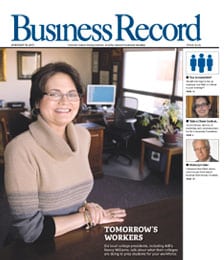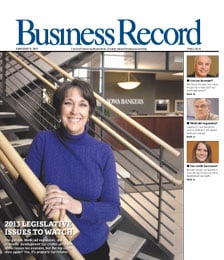Business is heating up

Keith Denner expects to pay as much as $35,000 per month this winter to heat an 1,100-unit apartment building he manages, an increase of about 50 percent over last year. But instead of panicking about it, he calls it an opportunity for his business.
Denner manages about 2,500 apartments through his company, Professional Property Management Inc. His apartments come with free heat, an amenity that has never seemed more important to tenants as it is right now, he says.
“Our rental traffic is way up – probably about 50 percent more than it has been the past two years,” Denner said. “We think that’s because people want to know they have predictability in their rental costs by not having to worry about heating costs.”
With heating costs projected to increase almost 50 percent this winter because of a sharply higher natural gas and home heating oil prices, Denner expects heating bills for his 1,100-unit Sun Prairie Apartment complex in West Des Moines to increase about $16,000 per month over last year. But he thinks increased occupancy in his units will offset that.
“Sure, heating costs are going up, but it’s certainly not a crisis situation for us,” Denner said. “For us and our tenants, we see an incredible opportunity. We expect renters can come to us and save money, and we hope to keep and attract new renters by offering this service.”
Denner is one of several people in Greater Des Moines whose businesses are improving because people are scrambling to find ways to minimize the pinch of high heating bills. One Ames home builder, HCS Builders Inc., is taking an approach similar to Denner’s by offering free heat for a year with the purchase of a new home, and it appears to be working. The company’s new home sales this past month have almost doubled from a year ago,
Heating contractors such as Bell Bros. Heating and Air Conditioning Inc. and Lozier Heating & Cooling are reporting a sales surge of high-efficiency furnaces and increased demand for furnace-cleaning services. The Fireplace Superstore in Urbandale is quickly selling out of its inventory of wood-burning stoves as people seek alternatives to natural gas.
KEEPING THEIR COOL
Besides banking on increased occupancy rates at his apartments, how does Denner keep his cool knowing that he is responsible so many people’s heating bills this winter? Because he planned ahead. Over the past 18 years, during construction of his apartments, he estimates that he spent an additional $5,000 per unit on energy-efficient appliances and materials such as thick insulation and window coverings, wood thermal-pane windows and 8-inch-thick walls.
“For all these years, I’ve spent hundreds of thousands of dollars extra building apartments that were energy efficient, and now we’ll sed our dividends,” Denner said. “Our bills are already so reasonable to start with that we know we can pull through this winter.”
At Sun Prairie, Denner estimates heating costs were about $30 per unit each month last winter. A 50 percent increase to this cost, when spread out over the course of the year, is slightly over $15 extra per month, Denner figures. Eventually, he said, he will have to pass that increase on to his tenants, but because the amount is so minimal, he doesn’t expect it to be an issue.
“Even if I have to pass that cost on, I think they’ll be wiling to pay that for the assurance of not having to pay that bill each month,” he said.
HCS Builders launched a free heat promotion of its own last month, advertising free heat for a year with the purchase of a new home. Bob Shirk, the company’s owner and treasurer, said he is not passing heating costs on to buyers, but subtracting it from his company’s profits on each home sold through the promotion.
Shirk said he decided to try the promotion as a way to offset the usual decrease in home sales during fall, and a housing market that has shown signs of slowing. The promotion applies to houses built on speculation, not custom-built homes. These homes are located in Ankeny, Ames, Nevada and Story City.
“With all the talk about high heating costs, we thought this promotion would catch people’s attention and bring a boost to our sales at a time of the year that tends to be slower for us,” Shirk said.
Since HCS started the promotion on Sept. 22, the company has sold seven homes, almost double its normal sales during this time of the year. The free heat offer is scheduled to end Nov. 15, but Shirk said there is a possibility that the company will extend it because of its success. Currently, he expects about 15 to 20 homes to be sold with this promotion.
“The buyers can hardly believe that we’re offering this,” he said.
Shirk said there is some risk involved with paying customers’ gas bills, especially if Central Iowa has a particularly cold winter, or if individual homeowners decide to set their thermostats at incredibly high temperatures. But for the most part, he’s confident that the promotion “won’t break the bank” because the homes are built to be energy efficient with their thick walls, insulation methods and energy-efficient heating and cooling systems.
“We build very energy-efficient homes, and this is a way for us to show that we stand by what we build,” he said. “This shows a real confidence from our standpoint that our houses are energy efficient and well-insulated.”
STAYING WARM
Many homeowners and business owners who are stuck with paying their own heating bills are taking measures now in hopes of lowering their expenses in the months to come.
MidAmerican Energy Co. has been inundated with requests for its free energy audits, according to Allan Urlis, the company’s director of media relations. Even though MidAmerican has hired additional employees to do energy audits, and has started scheduling appointments on Saturdays, there’s a long waiting list for this service.
“Right now, it depends on where you live,” Urlis said. “In Des Moines, you’re looking at a four- to six-week wait if you call now. That’s not bad, considering the Waterloo area is booked through the end of December.”
The energy audits, called HomeCheck or BusinessCheck, assess a building’s windows, doors and insulation levels, and the efficiency of its heating, cooling and water heating equipment. The energy auditor also collects information about energy use specific to that site, and uses all this information to make recommendations on how to save money on energy bills. During the inspection, the auditor may install energy-saving materials such as a water-heater insulation blanket, six feet of water pipe insulation and up to six energy-efficient light bulbs.
In September, Urlis said MidAmerican received 2,400 requests for energy audits, compared with fewer than 700 requests during the same month in 2004. The company began alerting its customers in August that heating costs were expected to climb this winter, and Urlis said he is glad to see so many people taking the message to heart.
“MidAmerican wants customers to use energy, but to use it wisely,” Urlis said. “The wise management of energy benefits customers and the company. If we’re managing the energy we use, we able to delay the need for additional energy infrastructure. That additional infrastructure can have an impact on rates.”
If the energy auditor recommends that a homeowner invest in new equipment or insulation to improve energy efficiency, MidAmerican offers rebates to help with these costs. The company increased the amount of those rebates in September.
Local heating contractors are also experiencing an increased demand for their services, both from customers who want to update their furnaces to more efficient models, and others who want to ensure that their existing equipment is in optimum working order.
Even though the life span for furnaces is around 18 years, many people aren’t waiting that long to update to a newer system. Gary Pennington, vice president of Lozier, said his company has been replacing furnaces that are as few as 8 years old for customers who want a higher-efficiency model.
“We’re taking out equipment that might be in good working order, but the customer wants to upgrade to that 94- or 95-percent efficiency furnace,” Pennington said. “If you’re expecting to pay out $350 to $500 per month on utilities, you could replace your units and get a return on your investment in just a few years.”
One rule of thumb Lozier shares with customers considering upgrading their energy system is to give it serious thought if their heating or cooling costs exceed $150 to $250 per month. Pennington says a person can calculate these costs by subtracting about $60 from the total utility bill to account for the utility base, or operating costs for household appliances.
Pennington estimated that the average Lozier customer spends about $6,000 to $8,000 to replace their heating and air-conditioning systems with high-efficiency models.
Bell Bros. also is “buried” with replacement installations, but also busy with furnace cleanings, according to Chuck Gassmann, the company’s vice president and general manager.
“What we’ve seen the most of is people calling in to have their furnaces cleaned and checked, and I would think we’re up 35 to 40 percent of people doing cleans and checks compared with a normal year,” Gassmann said.
Gassmann said these furnace checkups are recommended for homeowners each fall, along with air-conditioner checks in the spring. A dirty filter, burner or blower in a furnace can reduce airflow and furnace efficiency by as much as 25 percent, he said.
But when furnaces are older, sometimes a simple cleaning and checkup isn’t enough, he said.
“We tell people that if their furnace is pre-1992, it’s probably operating at an efficiency of 60 to 70 percent,” Gassmann said. “After 1992, the minimum went up to 80 percent.”
MODERN VS. OLD-FASHIONED
Gassmann estimates that about 86 percent of the builders Bell Bros. contracts with today use heating and air-conditioning units with an efficiency rating of 92 percent or above. But the company is currently working on a project with Hubbell Homes in its new “conservation community” in Waukee, Glynn Village, where each home will have a geothermal heat pump instead of a furnace. He said he expects to see more builders try this heating method in the future.
“Geothermal saves over a high-efficiency gas-heating system about 50 percent,” Gassmann said. “The installation costs of a geothermal heat pump are double when compared with a gas unit, but when you look at amortizing that additional cost over your mortgage, the energy savings the geothermal heat pump will provide will pay for itself, plus give you an extra $100 to $150 per month in savings.”
But other people are ignoring high-tech heating methods in favor of old-fashioned ones. Pennington said he’s talked with people who wanted to buy wood-burning stoves or corn burners.
The Fireplace Superstore’s inventory of wood-burning stoves is quickly being depleted by people hoping to reduce their spending on natural gas or LP fuel for heating, according to Jim Noon, the manager of the Urbandale store. He says increased sales of wood stoves across the country has caused an industry-wide shortage.
“Most dealers brought in what they thought was a season’s worth of products based on last year’s sales, but they quickly sold all these in August and September,” Noon said. “I still have four or five models in inventory, but if sales continue, I will also be sold out soon.”
Noon said the problem now is getting restocked. Factories have shipped all their inventory and can’t keep pace with market demand for the stoves, he said.
“We are having trouble getting restocked,” he said. “We’re having a banner year, but unfortunately, our year won’t be the year it possibly could have been had enough supply been available.”
Noon said many people buying wood-burning stoves live in rural areas, or somewhere where they have easy access to a supply of firewood. The cost to install a wood-burning stove with the proper pad, pipes and chimney is about $2,500 to $3,500, Noon said.
“This is just one piece of the puzzle of people trying to find alternative heat sources,” he said.







